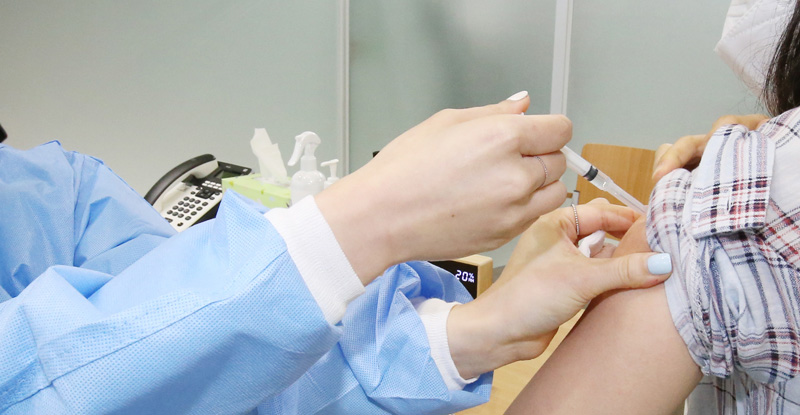|
View Larger Picture |
|
| ▲ In the morning of the 17th, the vaccination targets are getting the vaccine in the local vaccination center mock training held at the vaccination center in the indoor tennis court in Seobuk-gu, Cheonan-si, Chungnam. | |
| Ⓒ Photo co-recruitment group |
See related photos |
Of the 150 new cases reported as being suspected of adverse reactions after the COVID-19 vaccination, 149 cases were counted as cases such as muscle pain, headache, fever, chills, and nausea, which are common after vaccination. The government plans to hold a vaccination committee on the afternoon of the 20th to review the safety of the AstraZeneca vaccine.
The Corona 19 Vaccination Response Promotion Team (Director Eun-kyung Jeong) announced that as of 0 o’clock on this day, 11,132 additional people received the Corona 19 vaccination and completed the first dose of the Corona 19 vaccine for all 6,75,426 people. On a cumulative basis, the number of AstraZeneca vaccinations was 61,8852, and the number of Pfizer vaccinations was 56574.
“88.4% of the first vaccination target was inoculated,” said Bae Baeung-taek, head of the situation general manager of the Corona 19 Vaccination Response Promotion Team. In the case of, the inoculation rate was 82.2%.”
“The second vaccination will be conducted at the Central Vaccination Center starting from this day for workers in the Corona 19 patient treatment hospital.” “Until April 2 at the Central Vaccination Center, and March 30 at the Central, Honam, Yeongnam and Daegu Centers. Until the day, other self-inoculation medical institutions will have a second vaccination until April 10,” he added.
Report rate of 1.44%, most of cases such as muscle pain
There were 9757 cases of cumulative adverse reactions (reporting rate 1.44%), of which 9641 cases (98.8%) were common cases after vaccination such as muscle pain. Among them, 89 suspected cases of anaphylaxis, 11 serious suspected cases such as convulsions (one new case), and 16 cases of death reports are being investigated.
Anaphylaxis refers to the body’s overreaction to certain substances. Of the 89 suspected cases, 84 cases showed symptoms such as shortness of breath and hives within 2 hours after vaccination, which is different from anaphylaxis, the promotion team explained.
“On the 18th, the European Medicines Safety Agency (EMA) announced the results of the evaluation of the pharmacovigilance and risk assessment committee that there was no causal relationship between vaccination with AstraZeneca vaccination and thrombosis,” said Bae. “The benefits of vaccination are far greater than the side effects. Said. “In addition, on the 17th, the World Health Organization (WHO) recommended continuing the AstraZeneca vaccination,” he added.
At the same time, “The government held a vaccination expert committee from 3 p.m. on this day to review the safety of AstraZeneca vaccine-related domestic and overseas adverse reaction trends and EMA announcements, and focus on vaccination management in the second quarter (April to June). We plan to discuss about it,” he said.
WHO “AstraZeneca, with tremendous potential”
On the 19th (local time), the Corona 19 subcommittee of the WHO’s’Vaccine Safety Advisory Committee (GACVS)’ issued a statement and said, “AstraZeneca vaccine continues to maintain a positive’benefit-risk profile’. “It has tremendous potential to prevent infections and reduce deaths worldwide,” he said.
The subcommittee said it came to this conclusion as a result of reviewing available information and data on blood clots and thrombocytopenia after vaccination of AstraZeneca from Europe, the UK, and India.
“The data do not suggest an overall increase in coagulation conditions such as deep vein thrombosis or pulmonary embolism after COVID-19 vaccine administration.” Both diseases occur naturally and are not uncommon.”
“In Europe after vaccination with AstraZeneca, a very rare and unique thromboembolism, combined with thrombocytopenia such as cerebral venous sinus thrombosis (CVST), has been reported, but it is not clear whether it is due to vaccination.” He said, “It is recommended that countries continue to monitor the safety of all Corona 19 vaccines and report any suspected abnormalities.”
“Emergency room guidelines will be supplemented”
Despite the successive announcements of AstraZeneca vaccines by EMA and WHO, questions about adverse vaccine reactions were poured out at the Agency’s briefing on that day.
When asked,’Are you considering changing the plan by vaccinating the younger generations of the 2nd quarter vaccination and vaccinating the AstraZeneca amount to the elderly?’ “I replied.
Next, to the question,’Does the first responders in their 20s who have been identified as brain lesions correspond to the CVST suspicious condition discussed at EMA’,” he said, “We confirmed the findings that CVST may be suspected as a result of current brain imaging.” “The inspection is in progress,” he explained.
In addition, a question asked about the necessity of revising the domestic guidelines for “restricting use of the emergency room after vaccination”. Health authorities in the European Union and Germany announced that if a headache or dizziness appears after the AstraZeneca vaccination, they should seek medical attention as soon as possible.
Accordingly, an official from the Agency for Disease Control and Prevention said, “We will make an announcement message through the Vaccination Specialized Committee on this day and distribute it as soon as possible,” and “In the case of the emergency room, we will inform you immediately by supplementing this part as well as the existing general symptoms.” Replied.
In addition, “when evaluating the causality (of vaccines and body reactions), we have continued to partially evaluate individual cases as to whether (cause) is in the normal immune response, other adverse immune reactions, or other factors.” We plan to organize and operate an expert advisory group for evaluation, and the detailed composition plan is being discussed internally.”

